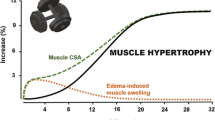Synopsis
Trimmed strips of stermomandibularis muscles taken from freshlyslaughtered cattle were placed in an isotonic myograph and cooled to 1°C. Spontaneous activity due to neuromuscular irritability was minimized by keeping muscle surfaces moist and anaerobic and was monitored by electromyography. Muscle strips were removed and frozen for histochemical analysis after they had completed their initial phase of cold-induced shortening (several hours). Control strips maintained for an equal time at 24°C rarely depleted the stainable glycogen in any of their muscle fibres so as to become PAS-negative. In chilled muscle strips, however, glycogenolysis was activated in some muscle fibres and they became PAS-negative. In serial sections, most of the PAS-negative fibres exhibited strong ATPase and weak succinate dehydrogenase activity. Fibres with weak ATPase and strong succinate dehydrogenase activity rarely became PAS-negative. These results are in agreement with biochemical reports of a cold-induced (<5°C) activation of glycolysis in skeletal musclepost mortem. Investigations on untrimmed lengths of excised sternoman dibularis muscle indicated that longitudinal muscle damage caused in cutting muscle strips for the myograph and/or their more rapid rate of initial cooling had facilitated the depletion of stainable glycogen.
Similar content being viewed by others
References
Bendall, J. R. (1973). Postmortem changes in muscle. In:The Structure and Function of Muscle (ed. G. H. Bourne) New York: Academic Press.
Bendall, J. R. (1975). Cold-contracture and ATP-turnover in red and white musculature of the pig,post mortem.J. Sci. Fd Agric. 26, 55–71.
Buege, D. R. &Marsh, B. B. (1975). Mitochondrial calcium andpostmortem muscle shortening.Biochem. biophys. Res. Commun. 65, 478–82.
Cassens, R. G. &Newbold, R. P. (1966). Effects of temperature onpost-mortem metabolism in beef muscle.J. Sci. Fd Agric. 17, 254–6.
Cassens, R. G. &Newbold, R. P. (1967). Temperature dependence of pH changes in ox musclepost-mortem.J. Fd. Sci. 32, 13–4.
Guth, L. &Samaha, F. J. (1970). Procedure for the histochemical demonstration of actomyosin ATPase.Expl Neurol. 28, 365–7.
Hale, L. J. (1965).Biological Laboratory Data, London: Chapman & Hall.
Newbold, R. P. &Scopes, R. K. (1967).Post-mortem glycolysis in ox skeletal muscle. Effect of temperature on the concentrations of glycolytic intermediates and cofactors.Biochem. J. 105, 127–36.
Swatland, H. J. (1975). Relationships between mitochondrial content of muscle fibres and patterns of glycogen depletionpostmortem.Histochem. J. 7, 367–74.
Swatland, H. J. (1976). Motor unit activity in excised prerigor beef muscle.Can. Inst. Fd Sci. Technol. J. 9, 177–8.
Swatland, H. J. (1977). Transitional stages in the histochemical development of muscle fibres during post-natal growth.Histochem. J. 9, 751–7.
Swatland, H. J. (1978). Comparison of red and white muscles by cytophotometry of their muscle fibre populations.Histochem. J. 10, 349–60.
Zugibe, F. T. (1970).Diagnostic Histochemistry. Saint Louis, Mosby.
Author information
Authors and Affiliations
Rights and permissions
About this article
Cite this article
Swatland, H.J. Low temperature activation ofpost mortem glycogenolysis in bovine skeletal muscle fibres. Histochem J 11, 391–398 (1979). https://doi.org/10.1007/BF01002767
Received:
Revised:
Issue Date:
DOI: https://doi.org/10.1007/BF01002767




